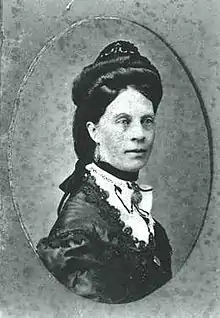Emily Harris (artist)
Emily Cumming Harris (28 March 1836 – 5 August 1925) was one of New Zealand's first professional women painters.[1] She chiefly painted New Zealand plants and flowers and worked mainly in water colour. She was born in Plymouth, Devon, England in about 1837 but spent most of her life in Nelson, New Zealand.[2]
Emily Harris | |
|---|---|
 | |
| Born | Emily Cumming Harris 1837 |
| Died | 1925 (aged 87–88) Nelson, New Zealand |
| Known for | Painting, Botanical Illustration |
Early life
Harris was the second daughter of five children of Sarah Hill and her husband Edwin Harris.[3] The Harris family emigrated from England on the "William Bryan", a ship of the Plymouth Company of New Zealand. They reached New Zealand on 31 March 1841.[2] Harris' father was a civil engineer and surveyor as well as a competent artist who supported his daughters efforts in painting.[3] Her mother was a teacher who established a primary school in Taranaki. Harris subsequently became an assistant teacher at that school.[4]
Following the outbreak of the First Taranaki War in March 1860, Harris was sent to Hobart to study while her family moved to Nelson. After spending several years in Australia she returned to Nelson where she joined her sisters in running a small primary school and giving private lessons in music, dancing and drawing.[4] She continued to paint but sales of her work were never sufficient to allow her to give up teaching to concentrate on her art full-time.[2] In 1890 Harris arranged for the family to hold an exhibition of her own and her father's and sister's art work, which raised sufficient funds to pay the family's debts.[3] The family again faced financial difficulties when Edwin Harris retired from teaching in 1889 (aged around 83).[3]
Exhibitions
Harris showed her work at exhibitions in New Zealand and overseas. In 1879 she exhibited at the Sydney International Exhibit where she was awarded a first degree of merit. She also exhibited at the 1880 - 1881 Melbourne International Exhibition.[2]
In 1885 she sent work to the Auckland Art Student's Exhibition[4] as well as to the New Zealand Industrial Exhibit where she won first prize and a silver medal for a painted screen. She was also awarded third prize for a painted table top.[2] In 1886 she was commended for work at the Colonial and Indian Exhibition in London and in 1888 -1889 again exhibited in Melbourne at the Centennial International Exhibition. She also organised exhibits of her own work in Nelson, Wellington, New Plymouth and Stratford in 1889 and 1890, and again in New Plymouth in 1899.[2] In 1896 she exhibited at her studio in Nelson.[5]
- Examples of paintings by Emily Cumming Harris
_Mt_Egmont._(1895%253F)_by_Emily_Cumming_Harris.jpg.webp) Various herbs from Mt Egmont
Various herbs from Mt Egmont_(1890s%253F)_by_Emily_Cumming_Harris.jpg.webp) Metrosideros tomentosa (pohutukawa)
Metrosideros tomentosa (pohutukawa)_by_Emily_Cumming_Harris.jpg.webp) Dianella intermedia (blue berry)
Dianella intermedia (blue berry)_by_Emily_Cumming_Harris.jpg.webp)
_by_Emily_Cumming_Harris.jpg.webp) Cordyline banksii
Cordyline banksii._Notothlaspi_australe._(1890s%253F)_by_Emily_Cumming_Harris.jpg.webp) Ranunculus, myosotis australis (yellow forget-me-not)., notothlaspi australe
Ranunculus, myosotis australis (yellow forget-me-not)., notothlaspi australe._A_small_tree_growing_in_North_and_South_Islands._It_is_thickly_covered_in_early_spring_with_golden_yellow_flowers._The_wood_is_(21478401788).jpg.webp) Sophora tetraptera (kowhai)
Sophora tetraptera (kowhai)
Published work
Harris published three books in 1890,[6] New Zealand Flowers , New Zealand Ferns and New Zealand Berries. These were later published in a single volume, Flowers, ferns and berries of New Zealand.[2] Harris also illustrated a children's book by Sarah Moore called Fairyland in New Zealand published in 1909.[4][7]
- Emily Cumming Harris (1894), New Zealand flowers., Nelson: HD Jackson, OCLC 5884225, Wikidata Q105286027
- Emily Cumming Harris (1894), New Zealand ferns, Nelson: HD Jackson, OCLC 54542186, Wikidata Q105286023
- Emily Cumming Harris (1894), New Zealand berries, Nelson: HD Jackson, OCLC 54542187, Wikidata Q105289802
- Emily Cumming Harris (1890), New Zealand flowers ; New Zealand ferns ; New Zealand berries, Nelson: HD Jackson, OCLC 1035301744, Wikidata Q105286022
Unpublished work
She completed a book entitled New Zealand Mountain Flowers in the 1890s which was never published. The Alexander Turnbull Library purchased the manuscript in London in 1970.[4]
Later life

Harris's professional artistic development and success was constrained by family obligations, straitened finances and the conventions of her time. However, in 1924 the Alexander Turnbull Library purchased 63 of her water colours.[2] Two limited edition sets of prints were issued from the collection in 1968 and 1979.[3] She continued to live and paint in the family home at Nile Street, Nelson, until her death aged 88, on 5 August 1925.[6] She is buried at Wakapuaka cemetery in Nelson.[8]
Further reading
- Emily Harris's Flowers, Berries and Ferns from Early New Zealand Botanical Art. (1985). F. Bruce Sampson.[9]
References
| Wikimedia Commons has media related to Emily Cumming Harris. |
- "Emily C Harris (1837-1925)". ketenewplymouth.peoplesnetworknz.info/. National Library of New Zealand. Retrieved 6 March 2015.
- Long, Moira M. "Emily Cumming Harris". Dictionary of New Zealand Biography. Ministry for Culture and Heritage. Retrieved 23 April 2017.
- Mary Creese (2010), Ladies in the Laboratory III: South African, Australian, New Zealand, and Canadian women in science : nineteenth and early twentieth centuries ; a survey of their contributions, OCLC 699866310, Wikidata Q104657105
- Sampson, F. Bruce (1985). Early New Zealand botanical art. Auckland: Reed Methuen. pp. 97–101. ISBN 047400015X. Retrieved 6 March 2015.
- "New Zealand Wild Flowers" (Volume XXX, Issue 303, page 2). Nelson Evening Mail. 23 December 1896. Retrieved 6 March 2015.
- Hoskin, Sorrel (21 July 2005). "Emily Harris – flowers, berries and ferns". Puke Ariki. Archived from the original on 3 November 2020. Retrieved 6 March 2015.
- Sarah Rebecca Moore (1909), Fairyland in New Zealand : a story of the caves / by Mrs. Ambrose E. Moore ; illustrated by Miss E.C. Harris., Illustrator: Emily Harris, Auckland: Brett Printing and Publishing, Wikidata Q105289992
- "Notable Women Walk - Nelson City Council". www.nelson.govt.nz. Retrieved 17 January 2019.
- "XI — Emily Harris's Flowers, Berries and Ferns | NZETC". nzetc.victoria.ac.nz. Retrieved 12 November 2020.